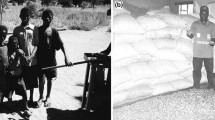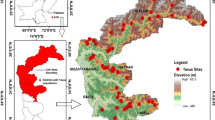Abstract
The Himalayan Yew (Taxus baccata subsp. wallichiana) is an endangered native high value medicinal plant of the Himalayan Region. The several medicinal properties of the bark and leaves of this species have increased its risk of extinction due to pressures for utilization. It is also subjected to harvest for fuelwood. The species does not regenerate well from seed and that is another risk factor. The objective of this research was to investigate the population ecology of the species as a foundation for its conservation. Six forest communities in the Khokhan Wildlife Sanctuary where the species is present were sampled. The abundance of the species, impacts of harvesting and its current regeneration patterns indicate that it may soon be extirpated from the Sanctuary. A plan for conserving the remaining sub-populations is presented. It could provide a template for conservation in other locations where the species is at risk.
Similar content being viewed by others
References
Anonymous 1997. The Wealth of India: a Dictionary of Indian Raw Materials and Industrial Products. NISC, CSIR, New Delhi.
Appendino, G. 1993. Taxol (Paclitaxel): Historical and Ecological Aspects. Fitoterapia LXIV: 5–25.
Curtis, J.T. and Intosh, Mc. 1950. The Interrelation of Certain Analytic and Phytosociological Characters. Ecology 31: 434-455.
Dhar, U., Rawal, R.S. and Samant, S.S. 1997. Structural Diversity and Representativeness of Forest Vegetation in a Protected Area of Kumaun Himalaya, India: implications for conservation. Biodiversity Conservation 6: 1045–1062.
Greig-Smith, P. 1957. Quantitative Plant Ecology. Academic Press, New York.
Joshi, H.C. and Samant, S.S. 2004. Assessment of Forest Vegetation and Prioritization of Communities for Conservation in a Part of Nanda Devi Biosphere Reserve, West Himalaya, India. International Journal of Sustainable development and World Ecology 11: 326–336.
Joshi, H.C. 2002. Assessment of Habitat Diversity, Forest Vegetation and Human Dependence in the Buffer Zone of Nanda Devi Biosphere Reserve of West Himalaya. Ph.D. Thesis submitted to Kumaun University, Nainital.
Kersaw, K.A. 1973. Quantitative and Dynamic Plant Ecology. Second Edition. Edward Arnold Limited, London.
Misra, R. 1968. Ecological Work Book. Oxford & IBH Publishing Company, Calcutta.
Mueller-Dombois, D. and Ellenberge, H. 1974. Aims and Methods of Vegetation Ecology. John Willey and Sons, New York.
Nandi, S.K, Pandey, A. and Palni, L.M.S. 1994. Cancer Cure from Himalayan Yew. Central Himalayan Environment Association Bulletin 7(4): 1–7.
Pant, S. 2005. Plant Diversity and Ethnobotany of Mornaula Reserve Forest in Kumaun, West Himalaya. Ph.D. Thesis. Kumaun University, Nainital.
Purohit, A., Maikhuri, R.K., Rao, K.S. and Nautiyal, S. 2001. Impact of Bark Removal as Survival of Taxus baccata L. (Himalayan Yew) in Nanda Devi Biosphere Reserve, Garhwal Himalaya, India. Current Science 81(5): 586–590.
Pushpangadan, P. and Nair, K.N. 2001. Future of Systematics and Biodiversity Research in India: Need for a National Consortium and National Agenda for systematic biology research. Current Science 80(5): 631–638.
Rikhari, H.C., Palni, L.M.S., Sharma, S. and Nandi, S. 1998. Himalayan Yew: Stand Structure, Canopy Damage, Regeneration and Conservation Strategy. Environmental Conservation 25(4): 334–341.
Rikhari, H.C., Sharma, S., Nadeem, M and Palni, L.M.S. 2000. The Effect of Disturbance Levels, Forest Types and Associations on the Regeneration of Taxus baccata: Lesson from the Central Himalaya. Current Science 79(1): 88–90.
Samant, S.S. and Joshi, H.C, 2004. Floristic diversity, Community Pattern and Changes of Vegetation in Nanda Devi National Park. In: Biodiversity Monitoring Expedition, Nanda Devi 2003 (18 June to 8 July, 2003), Uttaranchal Forest Department, Dehradun. Pp. 39–54.
Samant, S.S. and Pal, M. 2003. Diversity and Conservation Status of Medicinal Plants in Uttaranchal State. Indian Forester 129(9): 1090–1108.
Samant, S.S. 1993. Diversity and Status of Plants in Nanda Devi Biosphere Reserve. In: Scientific and Ecological Expedition to Nanda Devi. A Report. Army Head Quarters, New Delhi. Pp. 54–85.
Samant, S.S. 1999. Diversity, nativity and Endemism of Vascular Plants in a Part of Nanda Devi Biosphere Reserve in west Himalaya I. Himalayan Biosphere Reserve (Biannual Bulletin). 1(1&2): 1–28.
Samant, S.S., Dhar, U. & Palni, L.M.S. 1998: Medicinal Plants of Indian Himalaya: Diversity Distribution Potential Values. Gyanodaya Prakashan, Nainital.
Samant, S.S., Joshi, H.C., Arya, S.C. and Pant, S. 2002. Studies on the Structure, Composition and Changes of the Vegetation in Nanda Devi Biosphere Reserve of West Himalaya. Final Technical Report submitted to Ministry of Environment and Forests, New Delhi.
Shukla, G.P., Rao, K. and Haridasan, K. 1994. Taxus baccata in Arunachal Pradesh. Arunachal Forest News.
Singh, J.S. and Singh, S.P. 1992. Forest of Himalaya: Structure, Functioning and Impact of Man. Gyanodaya Prakashan, Nainital.
Ved, D.K., Kinhal, G.A., Ravikumar, K., Prabhakaran, V., Ghate, U., Vijaya Shankar, R. and Indresha, J.H. 2003. Conservation Assessment and Management Prioritization for the Medicinal Plants of Jammu & Kashmir, Himachal Pradesh & Uttaranchal. Foundation for Revitalisation of Local Health Traditions, Bangalore, India.
www.fao.org. 2000. Basic Information on Bhutan’s Himalayan Yew’s (Taxus baccata), Passing Wangchen Norbu, Assistant Director, Forest Inventory Unit, Forest Resource Development, Section, Thimphu. The Royal Government of Bhutan.
Author information
Authors and Affiliations
Corresponding author
Rights and permissions
About this article
Cite this article
Pant, S., Samant, S.S. Population ecology of the endangered Himalayan Yew in Khokhan Wildlife Sanctuary of North Western Himalaya for conservation management. J. Mt. Sci. 5, 257–264 (2008). https://doi.org/10.1007/s11629-008-0078-z
Received:
Accepted:
Published:
Issue Date:
DOI: https://doi.org/10.1007/s11629-008-0078-z




